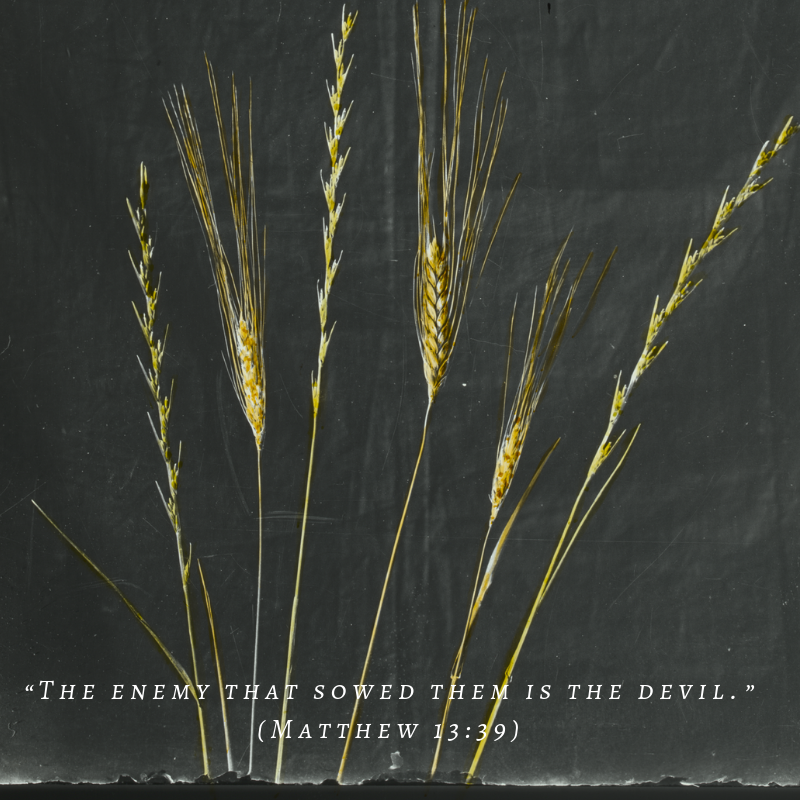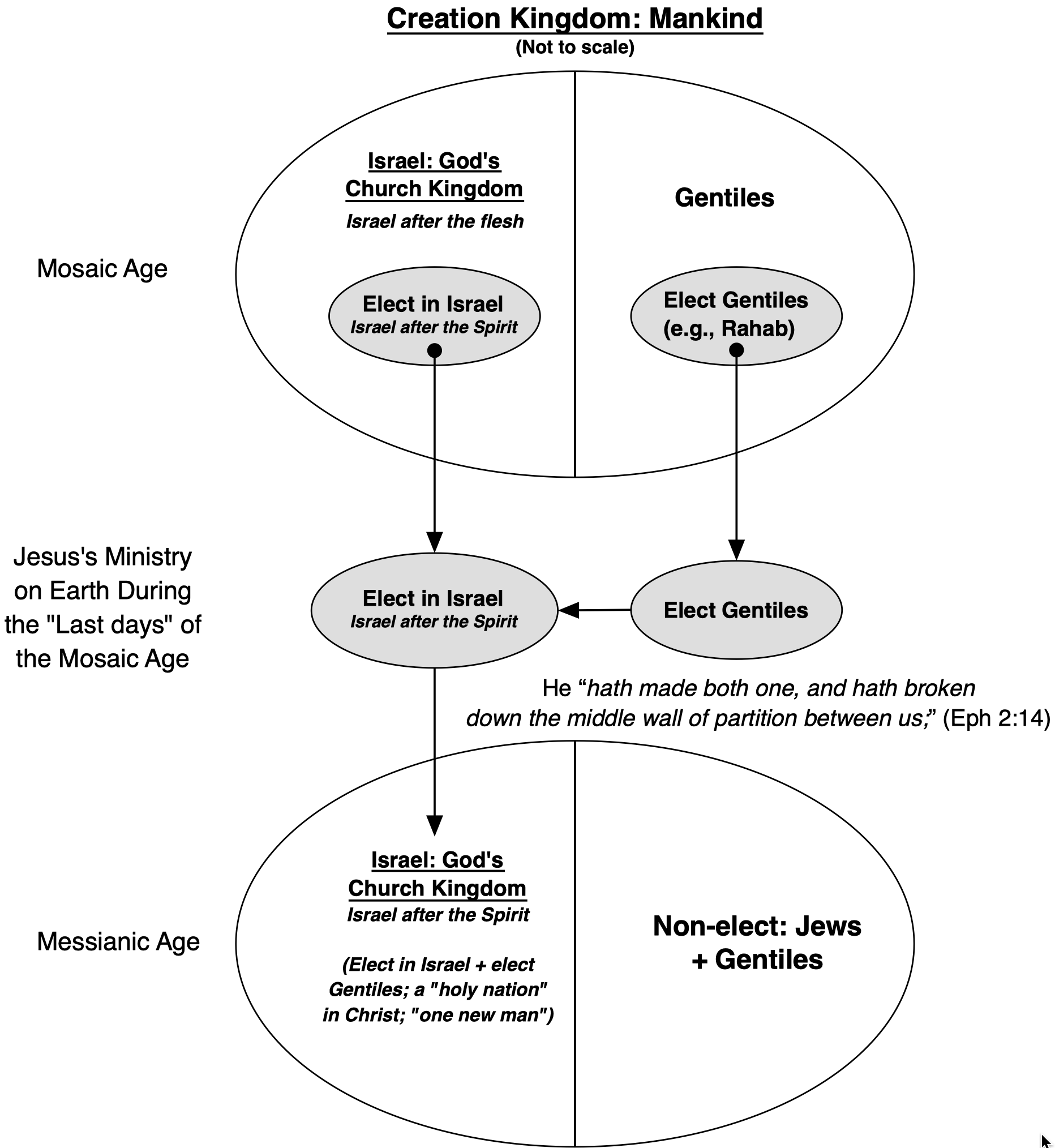
This post will appear during Thanksgiving week. Our forefathers in the United States established a tradition of thanking God for the year’s harvest. We continue that practice and here acknowledge our Father’s blessings this year.
A harvest of a different kind is the subject of our blog this week. We are working our way through Matthew. Our goal is to show how inmillennialism affects our understanding of this gospel.
Last week, we considered the first of Jesus’s “kingdom parables,” that of the sower (here). Now we will examine his parable of the weeds (Matt 13:24–30; 36–43).1
Both stories use a harvest to illustrate the kingdom of God.
The Common View
The common interpretation says this parable describes the kingdom in our age. The end to which it points is the final judgment after the resurrection. Blomberg summarizes this view:
From the actions of the farmer and the fate of the wheat and weeds, one learns that God will permit the righteous and wicked to coexist in this age but that he will eventually separate the wicked, judge them, and destroy them, while gathering the righteous together to be rewarded by enjoying his presence forever.2
There is much truth in this view. Good men exist together with bad in the world in this church age. After the (future) bodily resurrection, God will judge both. He will then make the final separation between them.
But this interpretation of the parable creates problems.
Kingdom Membership
The first problem involves kingdom participation. Jesus placed the tares in an inconvenient place. He said the angels would “gather out of his kingdom all things that offend, and them which do iniquity” (Matt 13:41). This separation requires the tares (i.e., wicked persons) to be inside the kingdom of heaven.
Consider the following image as an illustration. One cannot gather the four marbles on the table from among those inside the jar. He can only “gather out” marbles that are inside the jar.

The common interpretation of this parable says the tares (i.e., wicked) are inside the messianic-age kingdom.
This placement contradicts other passages that describe kingdom membership. Jesus said, “Except a man be born again, he cannot see the kingdom of God. . . . Verily, verily, I say unto thee, Except a man be born of water and of the Spirit, he cannot enter into the kingdom of God” (John 3:3–5).
The common view’s implied logic is:
Major premise: the tares are in the messianic-age kingdom of God (Matt 13:41)
Minor premise: all in the kingdom of God have the new birth (John 3:3–5)
Conclusion: the tares have the new birth.
The same problem appears in the apostles’ writings. Paul, for example, describes those who inhabit the kingdom. He asks the Corinthians a rhetorical question: “Know ye not that the unrighteous shall not inherit the kingdom of God?” Yes, we know the unrighteous will not inherit the kingdom in any sense.
But, God had qualified the Corinthians for this inheritance. Paul says, “And such [i.e., unrighteous] were some of you: but ye are washed, but ye are sanctified, but ye are justified in the name of the Lord Jesus, and by the Spirit of our God” (1 Cor 6:9–11; emphasis added). They were righteous through the grace of God. Therefore, they could inherit the kingdom.
Tares (i.e., the wicked) cannot enter the messianic-age kingdom of God. Therefore, they cannot be “gathered out” of it.
Church Discipline
The majority view of this parable also challenges church discipline. Jesus instructs his disciples to allow the tares and good seed to intermingle. “Let both grow together until the harvest” (Matt 13:30). Jesus specified no conditions that would allow an exception to this command.
William Hendriksen says this intermingling occurs in the churches. It occurs “inside the church visible.”3 The good seed must “grow together” with the bad in the visible church until the final judgment.
This view makes obedience to Paul’s church-discipline commands problematic. He tells the Corinthians “them that are without God judgeth. Therefore put away from among yourselves that wicked person” (1 Cor 5:13).
The Corinthians believers were “good seed.” The apostle did not want the tares (i.e., “wicked persons”) to remain with them in the visible church kingdom.
His instructions contradict Jesus’s explanation of our parable according to the common view.
“The End of the Age”
The majority opinion also ignores the time stamp in this parable. Jesus said the separation between the two kinds of seeds would happen “at the end of this age” (Matt 13:40, NKJV).
Thomas Whittemore describes this time marker:
The phrase rendered ‘end of the world’ is sunteleia tou aiōnos, and signifies literally, the conclusion of the age. The same expression occurs Heb. 9:26, where we read that Jesus appeared, at the conclusion of the age, to put away sin by the sacrifice of himself. As Christianity may be said to have begun when the Jewish religion ended, so Christ is said to have appeared at the end of the Jewish age. The apostle Paul stated, that the end of the age had happened in his day, ‘Upon whom the ends of the ages (ta telē tōn aiōnōn) are come.’ (1 Cor. 10:11.) The same subject is again spoken of Matt. 24:3, where we are informed, that the disciples asked the Saviour, what should be the sign of his coming, and of the conclusion of the age, (sunteleia tou aiōnos.) He speaks of the end of that age, in [Matt 24:6, 13, 14 in] the same chapter, and after pointing them to such signs as would infallibly enable them to discern its approach, he adds, [Matt 24:34,] ‘Verily I say unto you, this generation shall not pass, till all these things be fulfilled.’ On the strength of this testimony, plain, clear and incontrovertible, we say that the ‘harvest’ took place at the conclusion of the Mosaic age; and we add, that there is not an instance in the New Testament, in which the Greek phrase, rendered ‘end of the world’ in the parable on which we are remarking, has any other signification. It never should be forgotten, that the ‘end of the world,’ [Matt 13:39–40,] at which the harvest was to take place, was not the end of kosmos, the world said to be the field, but the end of aiōn, the age, and unquestionably referred to the conclusion of the Jewish state.4
The traditional view of the parable of the weeds says it applies to the end of history. It overlooks the historical situation in which Jesus spoke it. His parable was about the end of the Mosaic age, not the end of the physical cosmos.
The Inmillennial View
The inmillennial prophetic model offers solutions to these problems.
The Elements
Let us begin by examining the elements in this parable. Some of them are obvious and will require little explanation5
The sower is the Son of Man (Matt 13:37). Jesus may have applied this term to himself more than any other.
The field is the world (Gk. kosmos; Matt 13:38). This word signifies the natural order of things. It can signify the “world-order” of the physical creation.6 In this parable, Jesus may have used it to mean the order associated with God’s government of his creation. He was about to change that world order. During the Mosaic age, he ruled the world from the Temple in Jerusalem. In the messianic age, the Son of Man would rule from his throne in heaven.
The good seed represent the “children of the [messianic-age] kingdom” (Matt 13:38). Only the elect, redeemed, and righteous people of God are in this kingdom. It comprises true believers as they worship God in Christ’s churches. The wicked may assemble with the righteous, but they are not in the kingdom (cp. 1 John 2:19).
“The tares are the children of the wicked one” (Matt 13:38). In this parable, tares represent apostate Jews. Jesus said, “Ye are of your father the devil, and the lusts of your father ye will do” (John 8:44). They were “the children of the [Mosaic-age] kingdom” whom God would soon “cast out into outer darkness” (Matt 8:12).
The enemy that sowed the tares is the devil (Matt 13:39).
The harvest is “the end of the age” (Matt 13:39, ESV), the Mosaic age. The apostate Jews were “ripe” for this harvest. Joel used similar language to describe an earlier judgment of Israel. He said, “Put ye in the sickle, for the harvest is ripe: come, get you down; for the press is full, the fats overflow; for their wickedness is great” (Joel 3:13). Jesus is using this imagery to describe what would happen in the “great tribulation” in his generation (Matt 24:21, 34). We discussed this view above.
The angels are the messengers that attend the Son of Man as he establishes his kingdom. In some cases they are spirit-beings. Jesus said, “the Son of man shall come in the glory of his Father with his angels; and then he shall reward every man according to his works. Verily I say unto you, There be some standing here, which shall not taste of death, till they see the Son of man coming in his kingdom” (Matt 16:27–28).
God used human agents to destroy Jerusalem at the end of the Mosaic age. He “sent forth his armies, and destroyed those murderers, and burned up their city” (Matt 22:7).
These agents cast the tares into “into a furnace of fire” (Matt 13:42). This, too, is a common figure that describes Israel’s judgment-suffering. Ezekiel said,
And the word of the LORD came unto me, saying, Son of man, the house of Israel is to me become dross: all they are brass, and tin, and iron, and lead, in the midst of the furnace; they are even the dross of silver. Therefore thus saith the Lord GOD; Because ye are all become dross, behold, therefore I will gather you into the midst of Jerusalem. As they gather silver, and brass, and iron, and lead, and tin, into the midst of the furnace, to blow the fire upon it, to melt it; so will I gather you in mine anger and in my fury, and I will leave you there, and melt you. Yea, I will gather you, and blow upon you in the fire of my wrath, and ye shall be melted in the midst thereof. As silver is melted in the midst of the furnace, so shall ye be melted in the midst thereof; and ye shall know that I the LORD have poured out my fury upon you. (Ezek 22:17–22; emphasis added)
Other passages using “furnace” imagery include Deut 4:20; 1 Kings 8:51; Isa 31:9; and Isa 48:10.
The “furnace” of these passages is not the “the lake which burneth with fire and brimstone: which is the second death” (Rev 21:8). The latter is where God will cast the wicked after the final judgment. The former refers to temporal judgments.
The good seed are righteous persons who inherit the kingdom. As we saw above, this pertains only to those persons in Christ.
The Solutions
In inmillennialism, the “tares” and “good seed” existed together in the Mosaic-age kingdom. This coexistence is impossible in the messianic-age kingdom.
Our explanation of this position will draw from past posts, including Can God’s Kingdom Grow? and Israel: God’s Church Kingdom. Here is a chart from a post on Revelation, The Seven Mystic Figures—Part 1: Identities.

Let us match terms in Jesus’s parable to those in this chart. His “good seed” are the “elect in Israel.” The “tares” are members of Israel after the flesh. Both existed side-by-side in “Israel: God’s Church Kingdom” during the Mosaic age.
This was a composite kingdom from the beginning. Moses said, “a mixed multitude went up also with them” out of Egypt (Exod 12:38; cp. Lev 24:10). This mixture caused trouble: “the mixt multitude that was among them fell a lusting: and the children of Israel also wept again, and said, Who shall give us flesh to eat?” (Num 11:4). Jesus’s mixed-seed metaphor was fitting for the Mosaic age.
Jesus says, “Then shall the righteous shine forth as the sun in the kingdom of their Father” (Matt 13:43). In our chart, this kingdom is “Israel: God’s Church Kingdom” during the messianic age. The wicked “shall not inherit [this] kingdom of God” (Gal 5:21; emphasis added).
This view encourages church discipline. We should—with loving discernment—cast out tares from among us when they reveal their identity.
Conclusion
Inmillennialism helped us understand Revelation. A chart about Rev 12:1–14:20 helps explain the parable of the weeds. This shows the utility of this prophetic model. It will continue to provide natural interpretations for Jesus’s parables.
In our last post, we said inmillennialism’s interpretations do not prevent the application of the parables to other situations. Our first task, however, is to understand them in their original context. The prophetic model we are proposing helps with this task.
Footnotes
- The image in this post is Wild Flowers of Palestine: Tares and Wheat from the G. Eric and Edith Matson Photograph Collection. This file (here) is in the public domain (PD-US).
- Craig L. Blomberg, Matthew, vol. 22 of The New American Commentary (Nashville: Broadman & Holman, 1992), 219.
- William Hendriksen, Exposition of the Gospel According to Matthew, New Testament Commentary (Grand Rapids: Baker, 1973), 573.
- Thomas Whittemore, Notes and Illustrations of the Parables of the New Testament, rev. ed. (Boston: J. M. Usher, 1855), 99–101. I have transliterated his Greek. I modernized his Scripture references and replaced “Matt 24:33” with “Matt 24:34.” Whittenmore was a universalist. I suspect he embraced that false doctrine, in part, because his insights into prophecy did not fit within the existing interpretive models. Inmillennialism helps solve this problem.
- I will use Whittemore’s list as a guide in Notes and Illustrations of the Parables of the New Testament, 96–104.
- Henry George Liddell et al., A Greek-English Lexicon (Oxford: Clarendon Press, 1996), 985.
